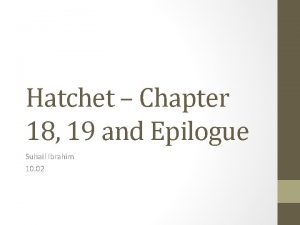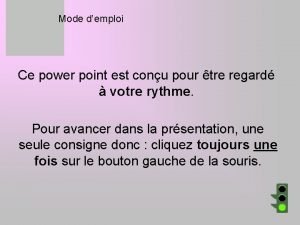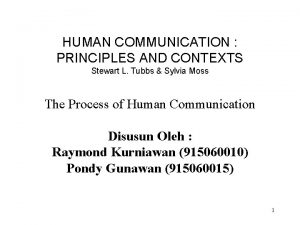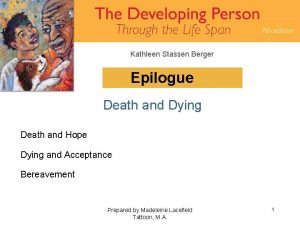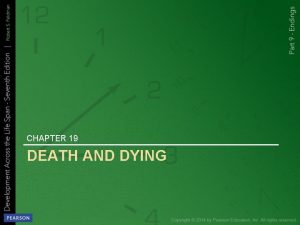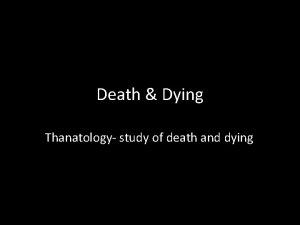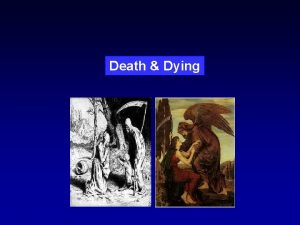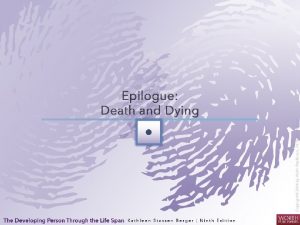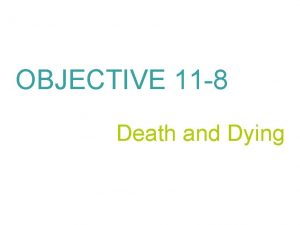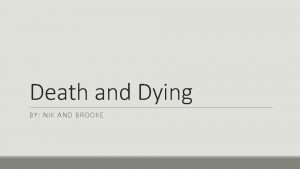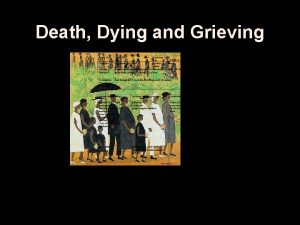EPILOGUE DEATH AND DYING Historical and Cultural Contexts
















- Slides: 16

EPILOGUE DEATH AND DYING

Historical and Cultural Contexts of Death and Dying • Morality rates, in developed countries, began to decline in 20 th century. • Leading causes of death shifted from acute, infectious disease to chronic, degenerative disease • Medical advances in end-of-life health care • Process of death and dying examined from a Western societal perspective

Figure EP. 1: Death Rates by Age in the United States, 2006

Defining Death • At one time death happened quickly, as there were no life-support medical advances • Persistent vegetative state – Higher cortical functioning has ceased while brain stem functioning • Brain death – All signs of brain activity have ceased for a specific period of time

Choices and Decisions at the End of Life • Determining Medical Care at the End of Life: Advanced Directives – Advance directives, a legal documents specifying the lifesustaining medical treatments people wish to receive, gives some personal control over decisions at end of life. – Living will provides directions about life-sustaining treatments the person does or does not want – Durable power of attorney authorizes a specific person to make health care decisions – Few Americans have these documents, partly due to misconceptions about the documents or discomfort with death

Figure EP. 2: A Sample Living Will

Choices and Decisions at the End of Life • Determining the Timing of Death: The Rights to Die – Desire to have control over timing of death often arises when a terminally ill patient’s pain and suffering can not be alleviated – Passive euthanasia – withholding treatment that would prolong life – Active euthanasia – actions that deliberately induce death – Physician-assisted dying – legal in several European countries and several states in the United States

Table EP. 1

The Experience of Dying • Kubler-Ross identified five stages experienced by dying persons – – – Denial Anger Bargaining Depression Acceptance • Experience of dying is affected by characteristics of the illness and the individual

Caring for Dying Persons • Although Americans prefer to die at home only 25% will do so • When needs of dying patients and their families are met, they are more likely to consider the death a “good death. ”

Caring for Dying Persons in Hospitals • 50 % of Americans die in hospitals and 25 % in nursing home • Hospitals are not equipped to meet the needs of dying individuals and family members – Staff experience demands on their time and need to maintain emotional distance – Patient pain may not be adequately managed

Caring for the Dying in Hospice Programs • Palliative care – designed to improve quality of life for patients with life threatening illnesses – Hospice care – care for terminally ill with less than 6 months to live • Emphasizes managing pain, showing respect for patient needs, supporting family members, and helping the patient prepare for impending death • Studies support distinct benefits for patients • Barriers to adequate end of life care, particularly for ethnic minorities

Video: Death and Dying

Losing a Loved One • Bereavement – objective experience of having lost a loved one • Grief – painful emotional responses to loss of a loved one – Can vary over time and from one person to the next – Can be difficult for some to overcome, particularly if the death is unexpected

Adjusting to the Loss of a Loved One • Dual process model of coping with bereavement – Coping with their feelings of loss – Coping with the changed realties of daily lives • Mourning – manner in which a person expresses grief – Shaped by cultural practices – Includes rituals, manner of dress, memorial events – Designed to facilitate transition to a new identity

Helping the Bereaved • It is helpful to show interest in bereaved person’s experiences and feelings. • Bereaved children have special needs. – By age 9 or 10 most children realize that death is permanent state – Children have less well-developed coping skills – May experience feelings of guilt or responsibility
 An attitude that is helpful in hospice work is
An attitude that is helpful in hospice work is Chapter 13 - death and dying
Chapter 13 - death and dying Hatchet chapter 18
Hatchet chapter 18 Solder cracked pride
Solder cracked pride The crucible epilogue
The crucible epilogue Epilogue the wife of noble character
Epilogue the wife of noble character What happened after the battle of marathon
What happened after the battle of marathon Epilogue of the watsons go to birmingham
Epilogue of the watsons go to birmingham Tpn epilogue
Tpn epilogue Midata coop
Midata coop Oxymoron examples
Oxymoron examples Shape matching and object recognition using shape contexts
Shape matching and object recognition using shape contexts Model komunikasi tubbs dan moss
Model komunikasi tubbs dan moss Template matching
Template matching Professional context examples
Professional context examples Writing in academic contexts
Writing in academic contexts Teachers in crisis contexts
Teachers in crisis contexts


